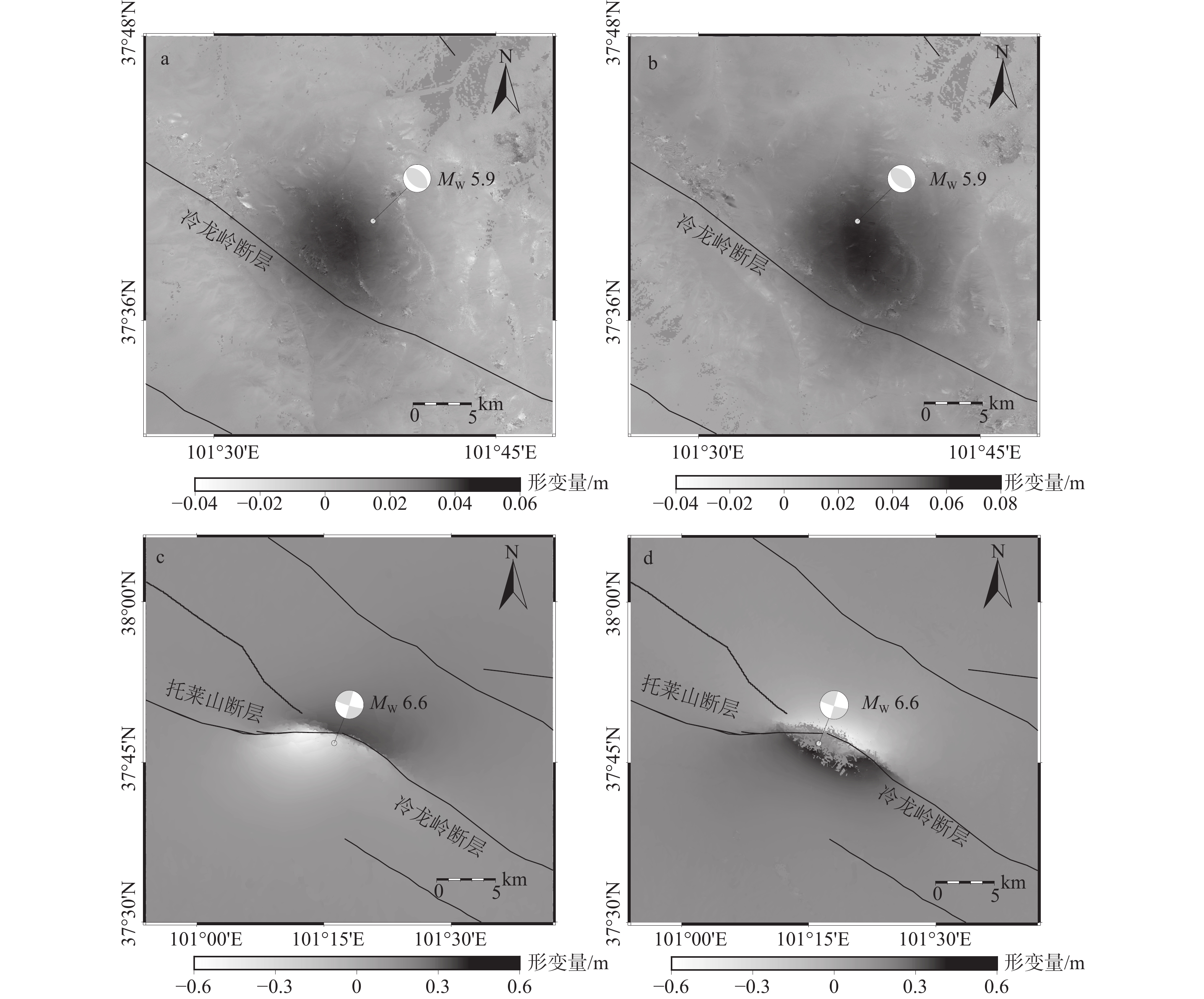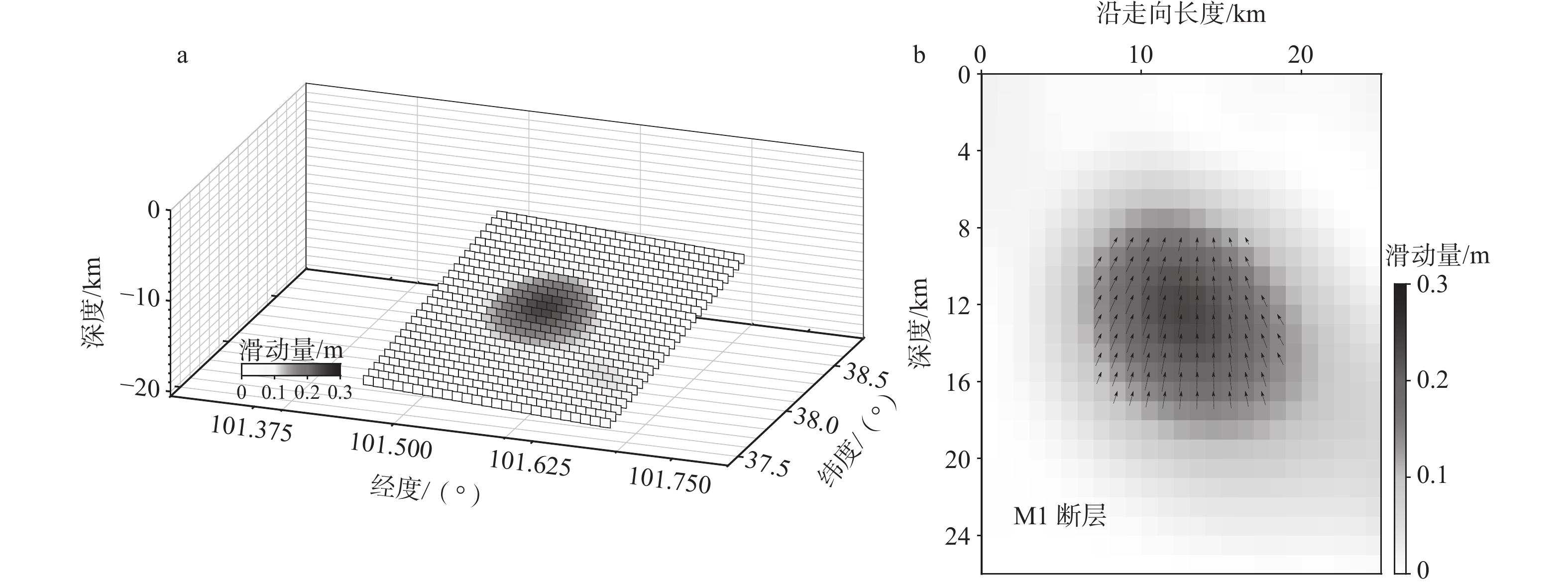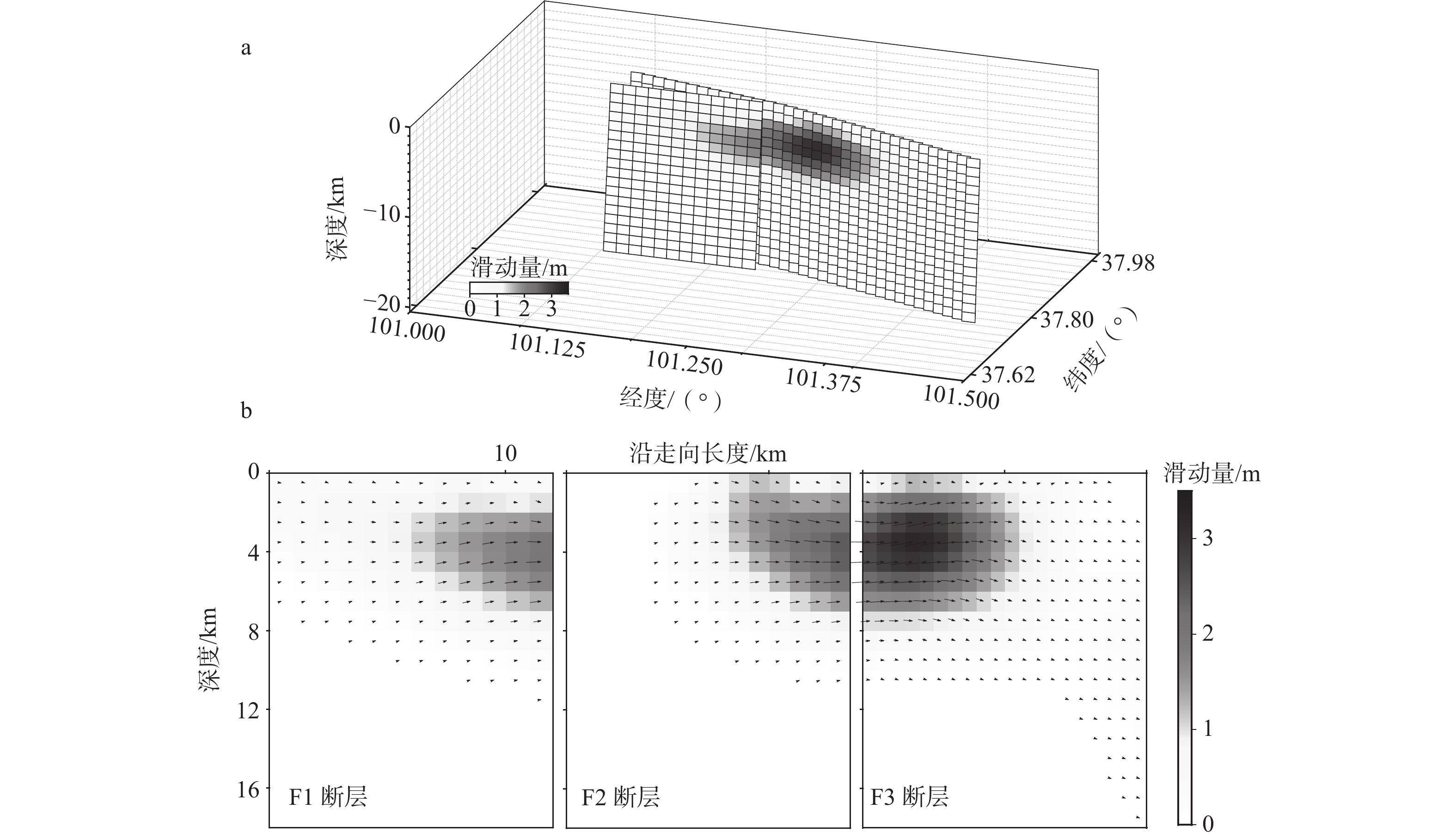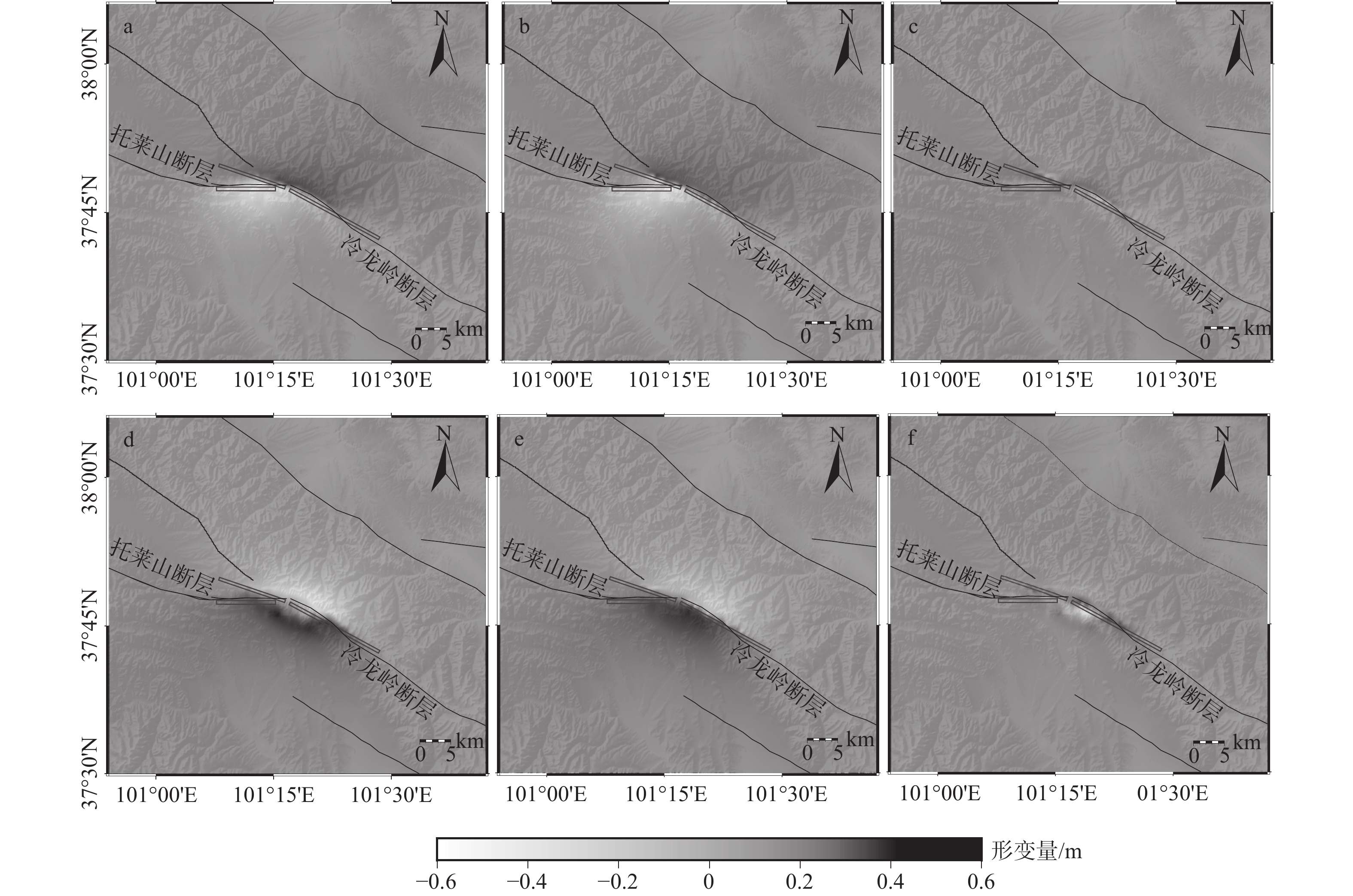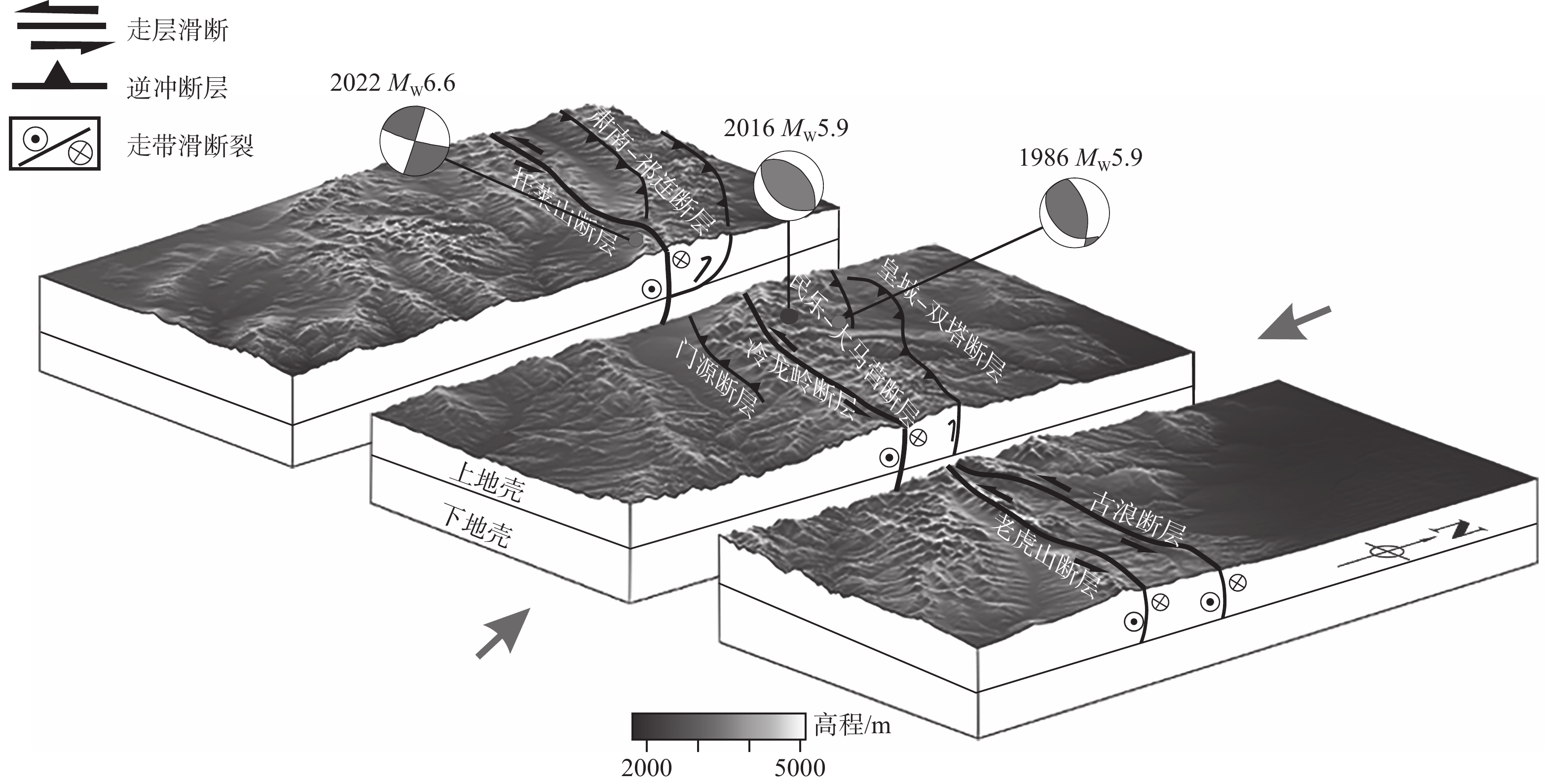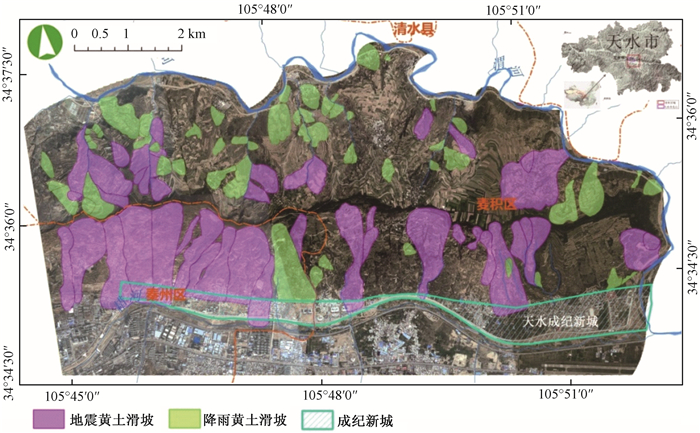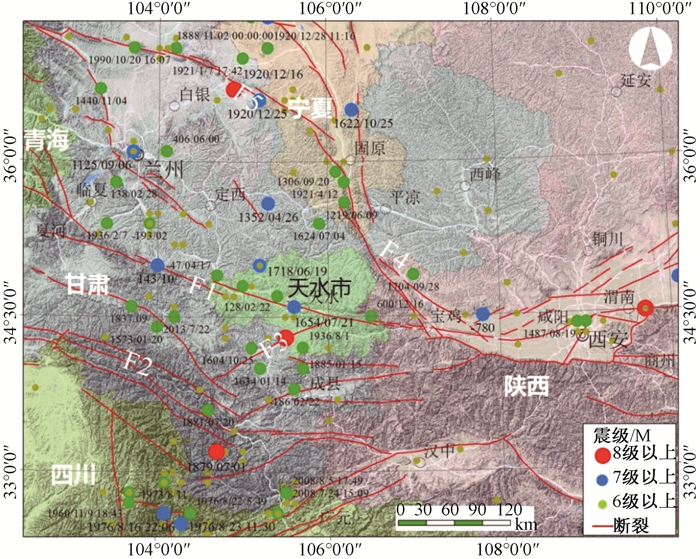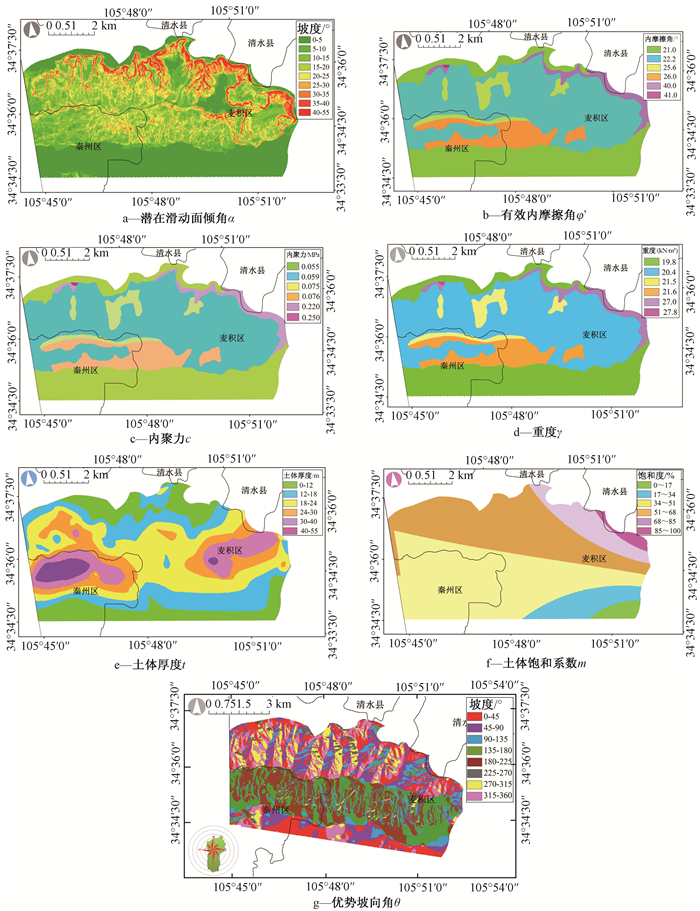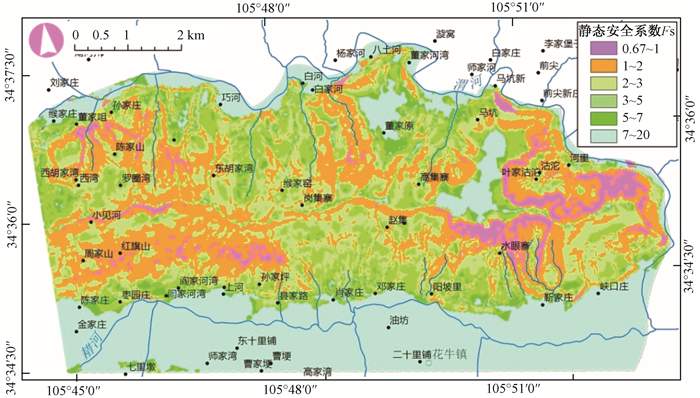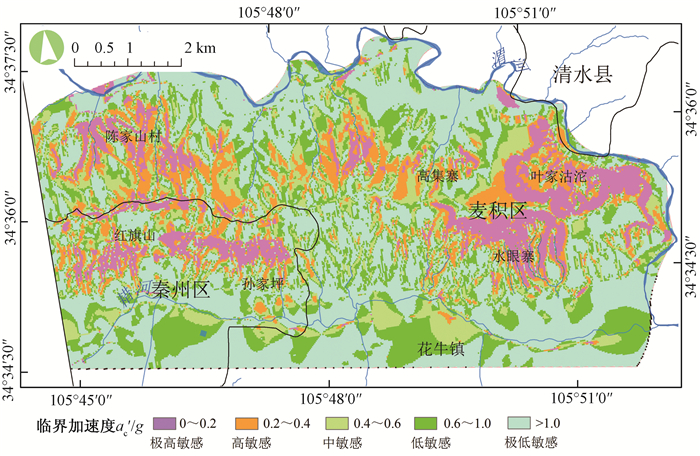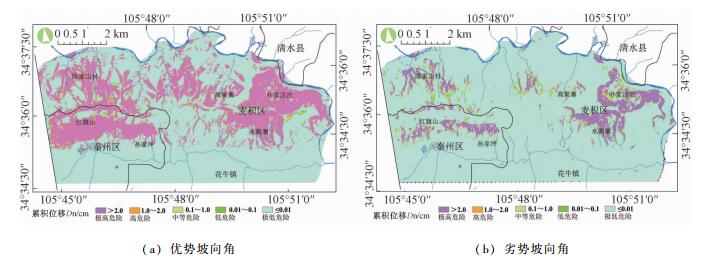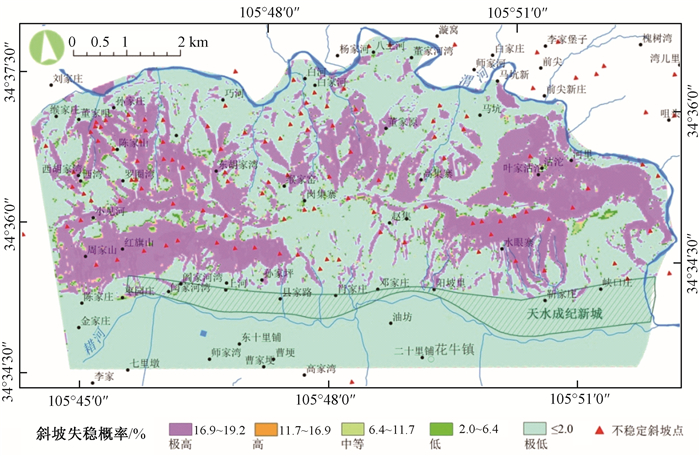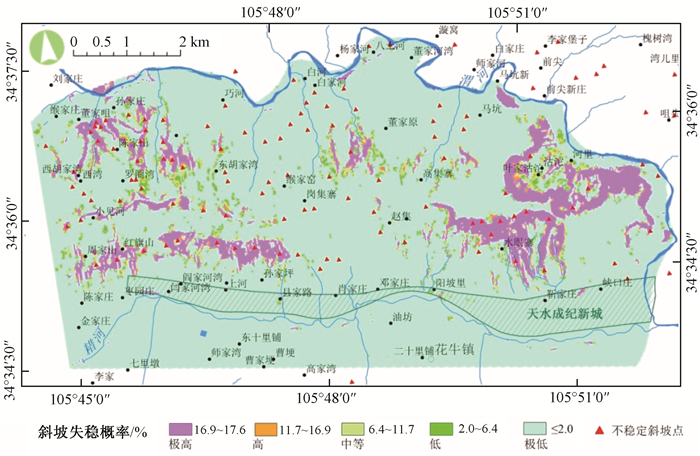InSAR deformation observation and regional severe earthquake hazard analysis of the 2016 and 2022 strong earthquake activities in Menyuan, Qinghai
-
摘要: 30多年来青海省门源县先后经历了3次强震,显现出活跃的地震活动。3次地震的震源机制存在显著差异,且震中均位于冷龙岭断层附近。为定量分析门源地震序列的活动特征,利用InSAR技术测量2016年和2022年门源地震引发的地表形变,详细分析了同震形变场的空间特征及发震断层,并据此建立了断层模型,通过最速下降法(SDM)获得2次地震的精细滑动分布,最后基于静态库仑应力变化评估了2022年门源MW 6.6地震对该区域及周边断层的应力扰动。研究发现2016年地震同震形变场表现为单一的椭圆隆升中心,运动属性以逆冲为主;而2022年地震形变场空间分布较为复杂,呈Y型分布,破裂走向自西向东有轻微变化,以水平形变为主。2次地震的滑动模式和深浅构造样式也存在明显差异:2016年地震活动性弱,在深部8~12 km存在一个滑动区,最大滑动量仅有0.23 m,断层面倾角低,具有深部滑动特点;而2022年地震为典型的浅源地震,存在3个明显的滑动区域,主破裂发生在冷龙岭段,集中在浅部1~7 km,最大位错量为3.22 m,冷龙岭断层向西延伸段也发生了明显滑动,最大滑动量达到2.59 m,托莱山段破裂深度集中在3~8 km,最大滑动量为2.1 m。结合1986年门源地震活动分析,推断门源地震序列受冷龙岭断层活动支配,冷龙岭断层在北东向扩展以及挤压缩短的活动趋势中,不断适应新的构造和应力调整。2022年门源MW 6.6地震位错影响范围较大,地震危险性需持续关注和深入研究,尤其是静态库仑应力变化超过了危险性阈值的部分。Abstract:
Objective Over the past 30 years, Menyuan Country, Qinghai, has experienced three strong earthquakes, demonstrating active seismic activity. The focal mechanisms of these earthquakes showed remarkable differences and the epicenters were all located near the Lenglongling fault. Methods In order to quantitatively analyze the activity characteristics of the Menyuan seismic sequence using InSAR technology to obtain the coseismic deformation field of the Menyuan earthquake of 2016 and 2022 and establish an appropriate fault model, the fine slip distributions of the two earthquakes were obtained through steepest decent method (SDM). Furthermore, the static Coulomb stress changes on the faults in the region and its surroundings caused by the Menyuan Mw 6.6 earthquake in 2022 were evaluated. Results The coseismic deformation field in 2016 exhibited a single elliptical uplift center, with predominantly thrust motion. In contrast, the spatial distribution of the deformation field in 2022 was more complex, showing a Y-shaped distribution, and there was a slight variation in the rupture direction from west to east, with primarily horizontal deformation. Conclusion The two earthquakes also differed in their slip patterns and shallow and deep structural styles. In 2016, the seismic activity was weak, with a slip zone existing at depths between 8 km and 12 km, where the maximum slip was only 0.23 m. The fault plane had a low inclination angle, which is a characteristic of deep-seated slip. By contrast, the 2022 earthquake was a typical shallow-focus earthquake featuring three distinct slip areas. The primary rupture occurred in the Lenglongling section, concentrated in the shallow part from 1 km to 7 km, with a maximum displacement of 3.22 m. A significant slip also occurred along the western extension of the Lenglongling fault, reaching a maximum slip of 2.59 m. The Tuolaishan section experienced rupturing mainly between 3 km and 8 km, with the maximum slip recorded as 2.1 m. Significance Combined with the analysis of the Menyuan earthquake activity in 1986, it is inferred that the Menyuan earthquake sequence is dominated by the activity of the Lenglongling fault, which is continuously adapting to new structures and stress adjustments in its northeast extension and shows compressive-shortening activity trend. The 2022 Menyuan Mw 6.6 earthquake had a significant impact range, and earthquake hazards need to be continuously monitored and studied further, especially in areas where static Coulomb stress changes exceed the hazard threshold. -
Key words:
- Menyuan earthquake sequence /
- Lenlongling fault /
- InSAR /
- activity characteristics /
- coulomb stress
-
0. 引言
Newmark累积位移模型在地震滑坡风险评估中得到广泛应用,且不断得到方法上的改进和完善。Newmark建立刚塑性体的滑块模型,依据地震动峰值加速度值和地震力来计算滑坡位移,这也为基于GIS对地震滑坡的危险性评价提供了理论基础[1]。基于典型模型方法,Wilson等对美国加利福利亚州(State of California)的洛杉矶地区(Los Angeles District)自然斜坡开展了区域地震滑坡的风险评估,对此方法的推广应用很有启发性[2~3];Wieczorek等对加利福利亚周圣马特奥镇(SanMateo)进行了地震滑坡易发性的实验性编图研究[4];Jibson等对加利福利亚州北岭市(Northridge)1994年地震诱发的滑坡进行了危险性评估[5]。Roberto和Refice等利用简化Newmark模型与蒙特卡洛(Monte Carlo)方法相结合,在意大利地区进行了地震滑坡危险性评估[6~7];Godt等对汶川地震滑坡易发性开展了快速评估的尝试[8],结果表明此方法适用于较大区域(小比例尺)地震滑坡的评估。
国内的张春山等对夏呀河滑坡开展了单体滑坡的风险评估,推动了对单体滑坡灾害风险评估的方法和定量评估模式[9];李典庆等开展了考虑时间效应的风险评估,着重从时间效应风险滑坡风险评估的因素[10];乔建平等对区域滑坡进行了风险性概率分区[11];王涛等以Ms8.0级汶川地震为例,对震中附近区域使用简化Newmark位移模型法进行了区域性地震滑坡危险性快速评估,显示了评估方法的可行性[12];徐光兴等建立了地震强震动下边坡累积位移预测模型[13];陈晓利等则对庐山地震使用Newmark法进行了地震滑坡的预测研究,表明此方法具有可行性和实用性[14]。
现阶段的Newmark累积位移法模型在滑坡危险性评估中存在以下不足:(1) 地震波加速度时程分为UP、NS、EW三个方向,使用回归方程取代单一方向相应的积分运算,考虑了震源或断裂的方向性,但是忽略了研究区斜坡的方向性;(2) 栅格计算的时候以单元栅格独立计算,忽略了相邻单元之间的关系,栅格与栅格之间未能搭建起关系,计算的结果存在偏差;(3) 在累积位移的计算中,无法做到单独栅格对某一地震加速度数据开展直接积分运算,降低了计算结果的准确性。本文尝试在野外调查数据的基础上,通过地理空间数据的统计分析,首次引入斜坡坡向和震源方位角的关系,对天水市北山开展基于Newmark累积位移模型的危险性分析,进一步完善地震滑坡的评估方法,为天水市减灾防灾提供理论基础和技术指导。
1. 天水市北山概况
天水市北山(下文简称“北山”)位于甘肃省天水市秦州区和麦积区交界,地处陇山山地与陇西黄土高原的过渡地带,是典型的黄土梁峁地貌,南北边界分别为藉河和渭河河谷冲积平原,藉河左岸冲积平原比渭河宽。北山东部为黄土塬,中部和西部为黄土梁,整体而言北坡比南坡坡度大。藉河在北山东南的社棠镇西侧汇入渭河。北山海拔最高点(1500 m)位于东部的黄土塬上,最低点(1120 m)位于渭河最东段河床上,高差380 m,北山总面积约41 km2。出露地层主要为第四系黄土,约占86%,厚度约15~45 m,南坡水眼寨附近出露面积约10%的新近系泥岩,北坡渭河岸坡出露少量下古生界牛头河群变质岩。北山主要的斜坡类型有:岩土二元结构斜坡、土质斜坡和岩土混合斜坡三类。天水市成纪新城选址于南坡藉河左岸河谷盆地(见图 1)。
北山位于青藏高原东缘,北部、东北部发育六盘山断裂和海原断裂,走向为北偏西。西南部为迭部—白龙江断裂,基本走向为北西西。南部有北东东向的成县盆地北缘断裂、平武—青川断裂和近东西走向的成县盆地南缘断裂。东部有走向近东西的渭河断裂和秦岭北麓断裂。北山区域属于潜在强震区或强震扰动区,周边区域历史上共发生55次Ms=6.0及以上地震,其中发生在麦积区范围的地震有734年天水7.0级地震和1654年天水南8.0级地震,震中位置分别为马跑泉镇一带[15]和天水镇西北一带[16](见图 2)。地震在该地区诱发了大量的黄土滑坡,据统计仅北山就发育了55个地震黄土滑坡(见图 1),其中多为大型—巨型滑坡远程滑坡,平均滑距达969 m,地震滑坡面积约占北山面积的17.3%,给当地的生命财产安全造成了严重威胁[17]。
2. 引入坡向角的Newmark累积位移法计算原理
Newmark模型基于极限平衡理论,该模型中滑块的永久位移是在地震加速度荷载作用下,斜坡块体沿着最危险滑动面发生瞬时失稳后位移不断累积所得。当施加于最危险滑动面处的加速度超过临界加速度时,块体即沿滑面发生滑动,将外荷载加速度与临界加速度的差值部分曲线对时间进行二次积分即可得到永久位移值。
临界加速度ac指在地震动荷载作用的条件下,斜坡滑体的下滑力等于斜坡内的抗滑力时(即力的极限平衡状态)的地震动加速度值在斜坡坡向角的分解值a′t(见图 3)。由于一次地震波的方向是固定的,而斜坡的坡向值是不固定的,无法对栅格进行定量计算,通过数学变换的方法,斜坡临界加速度分解到单一固定地震波方向上,此时的斜坡临界加速度为a′c,计算结果与地震波分解到斜坡方向上是一致的。通过比较静力和地震动力条件下滑体的受力状态,利用无限斜坡法计算安全系数Fs间接公式(1) 推导得出,g为地球重力加速度,α为斜坡面的倾角,β为斜坡坡向角,θ为地震波加速度方位角:
a′c=(Fs−1)g⋅sinα/abs cos(θ−β) (1) 其中Fs为无限斜坡法计算出来的安全系数,其计算如式(2) 所示:φ′为斜坡土体的内摩擦角,α为斜坡的坡角,c′为斜坡的内凝聚力,γ为坡体物质密度,γw为水的密度,m为滑体条块被水浸入的厚度比例,t为坡体的厚度。
Fs=cγtsinα+tanφ′tanα−mγwtanφ′γtanα (2) 利用临界加速度a′c计算滑块累积位移,还需要地震动加速时程曲线数据,加速度值小于等于a′c的部分对滑块不产生位移,而将大于a′c的加速度时程对t进行一次积分求出滑块对应时间的速度时程曲线见图 4,按式(3) 二次积分可得滑体累积位移时程曲线:
Dn=∫t0∫t0[at−a′c]dt (3) 3. 北山地震黄土滑坡易发性评价
根据地层岩性和岩土体工程特性,按照工程地质分类标准[18]将研究区内工程岩组划分为4种类型:坚硬岩组、较坚硬岩组、较软弱岩组、软弱岩组。较软弱岩组和软弱岩组则均为第四纪黄土松散沉积物,其土体参数值基于北山的红旗山滑坡和渭河北岸的锻压机床厂滑坡两处岩土体测试结果,再综合该地区的已有成果资料,得到本文研究各类岩土体的物理力学参数(见表 1)。
表 1 北山岩土体物理力学参数取值表Table 1. Physical and mechanical parameters of rock and soil in Beishan岩组 坚硬
(变质岩)较坚硬
(砂砾岩)较软(松散
沉积物,
藉河,
红旗山)软弱(松散
堆积物,距河
流较近,
锻压厂)φ′/° 40 35 24.5 22.2 c′/Pa 220000 140000 90400 59500 γ/(N·m -3) 24500 23000 17800 17500 利用DEM数据生成斜坡坡度栅格图,结合研究区滑坡滑动面倾角进行插值改进,得到斜坡潜在滑动面倾角(α)栅格图层(见图 5a);根据1:5万地质图基础数据,进行数据矢量化,然后利用图幅内的红旗山滑坡和渭河北岸的锻压机床厂滑坡的岩土物理力学测试结果进行属性赋值,最后转为有效内摩擦角(φ')、内聚力(c)和岩土体重度(γ)栅格图层(见图 5b—图 5d);北山共发育108个新老滑坡,通过详细野外调查,获取了每一个滑坡的滑坡体大致厚度数据,利用自然邻域法插值分析,从而得到北山土体的厚度(t)分布栅格数据(见图 5e);收集麦积区内6个村雨量站在2013年6~7月两次强降雨中记录的过程雨量,取两个月的平均值为点源数据,利用ArcGis进行降雨量插值,生成过程雨量均一化数据后作为土体饱和系数(m)的栅格数据(见图 5f);使用DEM提取栅格的坡向角进行分析,得到优势坡向角值θ (见图 5g)。
由公式(2) 可以求出北山区域静态安全系数Fs的栅格图层,将计算结果分为六个等级(第六级为坡度小于5°的区域),得到不同分级的静态安全系数Fs的分区图(见图 6)。研究区东侧的水眼寨、叶家沽沱、董家咀、孙家坪以及红旗山地区的安全系数最低,约占研究区面积的4%;周家山、小见河、罗圈湾、东胡家沟到孙家坪等周边的Fs为1~2,属于较敏感区域,占研究区面积的23.5%;南部的藉河河谷盆地、东侧的黄土塬和北部的渭河河谷较为平缓,坡角在5°范围,安全系数极高,面积约为38%;其他地方安全系数处于2~5之间,约占19.3%。
利用公式(1) 计算得到优势坡向角下临界加速度栅格图(见图 7)和劣势坡向角下的临界加速度栅格图(见图 8),其中优势坡向角指的是地震波和斜坡坡向角方向一致,劣势坡向角指的是地震波与斜坡坡向角垂直。临界加速度值分为五个等级:极高敏感度(0~0.2g),高敏感(0.2~0.4g),中敏感(0.4~0.6g),低敏感(0.6~1.0g)和极低敏感(>1.0 g)。对比图 7和图 8可知:优势坡向角下极高敏感度明显比劣势坡向角下的范围大,二者的面积比例分别为37.8%和10.6%;高敏感度面积比分别为17.8%和11.4%。
4. 北山地震黄土滑坡危险性分析
徐光兴等利用汶川地震时记录到的大量强震动记录,建立了基于临界加速度比、Arias强度和地震剩余强度的永久位移预测模型[13](式4)。根据根据第五代《中国地震参数区划图》(GB 18306-2015),北山区域PGA取0.3g,计算得到优势坡向角下的累积位移Dn1栅格图和劣势坡向角下的累积位移Dn2栅格图(见图 9),分为五个级别:极高危险、高危险、中等危险、低危险和极低危险。
lg(Dn)=0.194+lg[(1−a′cPGA)2.262⋅(a′cPGA)−1.754] ±0.371 (4) Newmark模型求出的累积位移Dn与边坡失稳不存在直接联系,但可将其与实际的地震黄土滑坡编目进行对比分析以确定Dn与地震黄土斜坡失稳概率P(Dn)之间的关系。据Jibson与葛华的相关研究表明[15, 19],以地震诱发滑坡编目为数据源,建立的地震黄土斜坡失稳概率指数K与累积位移Dn的回归方程如公式(5):
P(Dn)=k⋅[1−exp(a×Dn)b] (5) 其中中括号内为Weibull方程,P(Dn)表示斜坡在地震动加速度作用下产生累积位移Dn时诱发滑坡的失稳概率,系数k表示P(Dn)最大值,而a与b作为选定参数,用每个分组内处于滑坡区域的累积位移Dn栅格单元数量除以分组内Dn栅格数量的值算出。使用ArcGIS进行重分类(Dn取中间值),计算出每一类位移值的总面积A,再将地震黄土滑坡数据与累积位移数据重分类图层进行相互分析,计算出累积位移内的地震黄土滑坡面积a,取P(Dn)=a/A,见表 2。
表 2 累积位移Dn的Weibull函数拟合参数表Table 2. The table of Weibull function fitting parameter of cumulative displacementDn P(Dn) 0.005 0.0891 0.05 0.0936 0.5 0.1566 1.5 0.1720 2.0 0.1921 通过公式(5) 和表 2的参数,对累积位移栅格数据进行计算,得到优势坡向角和劣势坡向角下的斜坡发生失稳概率分布图。使用自然断点分级法(Jenks)把发生斜坡失稳概率分为五级:极高、高、中等、低和极低。图 10为优势坡向角下的斜坡失稳概率栅格图,最大失稳概率为19.2%,最小为0.1%,与累积位移分区图(见图 9)基本吻合:水眼寨、叶家沽沱、陈家山、周家山、红旗山、缑家窑和董家塬一带失稳概率最高;藉河和渭河河谷、河漫滩及河谷冲积平原地带失稳概率最小,在2%以下;县家路村—赵集寨—坡阳里一带的斜坡失稳概率较低。
图 11为劣势坡向角下斜坡失稳概率图,优势坡向角下的失稳概率区域面积明显比劣势坡向角下失稳概率区域面积大。对比二者的失稳概率图可以看到:失稳概率极高和高的区域明显变小,由32.4%下降到10.1%;周家山—孙家坪北、水眼寨、叶家沽沱和陈家山—西胡家湾一带地区的失稳概率最大值为17.6%,失稳概率为高—极高。根据北山现有滑坡分布和不稳定斜坡发育的调查结果显示:优势坡向角下的计算结果和北山不稳定斜坡调查结果基本吻合。成纪新城西区闫家河村到孙家坪一带和东区水眼寨村南一带为失稳概率高区域,存在较大地震黄土滑坡风险,建议加强该地区滑坡变形监测,开展减灾应对措施。
5. 结论
本文通过天水市北山野外调查和室内分析相结合的方法,开展基于Newmark累积位移法的地震黄土滑坡危险性分析。分析了研究区的孕灾背景,结合现有滑坡和不稳定斜坡的调查数据,在充分考虑了震源方位角和斜坡坡向角的角度关系基础上,对优势坡向角和劣势坡向角下的斜坡易发性进行计算和对比,然后用回归方程求出PGA为0.3g时斜坡的累积位移,最后计算斜坡在地震荷载下的失稳概率,得到结论以下:
(1) 天水市北山及周边构造发育、历史地震频发,诱发了大量地震黄土滑坡,滑坡面积占到北山面积的27%,该区域属于潜在强震区或强震扰动区。
(2) Newmark累积位移模型中引入研究区优势坡向角变量,对地震黄土滑坡危险性评价的结果准确性有提高作用。通过北山的危险性分析结果对比,在不考虑斜坡优势方位角下北山的斜坡失稳概率分区图的识别率低,且与调查结果不符;而劣势坡向角下的结果和实际情况存在较大差距;优势坡向角的斜坡失稳概率和该区域调查结果吻合,在1:5000比例尺区域有较好实用性和合理性。对Newmark模型在地震黄土滑坡危险性评估中引入斜坡坡向角和震源方位角关系,有利于提高小区域(大比例尺)风险评估的准确性。
(3) 北山的周家山—孙家坪一带、水眼寨一带、叶家沽沱一带和罗圈湾—陈家山一带的在地震扰动下斜坡失稳概率为16.9%~19.2%,为极高危险区。成纪新城西区的红旗山—孙家坪一带、东区的水眼寨南一带均为高—极高危险区,建议加强对该地区地质灾害监测,开展减灾设施建设,保证在建和拟建工程的安全运营。
-
图 1 冷龙岭断层带及周边活动构造
箭头表示GPS速度场(数据来自Wang and Shen, 2020);3个沙滩球分别代表 2022年MW 6.6、2016年MW 5.9和1986年MW 5.9地震;圆点分别是Fan et al.(2022)和Liu et al.(2019)在2022和2016年地震中重新定位的余震TLSF—托莱山断层;LLLF—冷龙岭断层;JQHF—金强河断层;MMSF—毛毛山断层;HYF—海原断层;LHSF—老虎山断层;GLF—古浪断层 ;MYF—门源断层;SN-QLF—肃南−祁连断层;ML-DMY—民乐−大马营断层;HC-STF—皇城−双塔断层;TJS-XSF—天景山−香山断层
Figure 1. Lenglongling fault and surrounding active structures
The arrows represent the GPS velocity field (from Wang and Shen, 2020). Three colored beach balls represent the 2022 MW 6.6, 2016 MW 5.9, and 1986 MW 5.9 earthquakes; dots are the relocated aftershocks of the 2022 and 2016 earthquakes from Fan et al. (2022) and Liu et al. (2019) respectively. TLSF−Tuolaishan fault; LLLF−Lenglongling fault; JQHF−Jinqianghe fault; MMSF−Maomaoshan fault; HYF−Haiyuan fault; LHSF−Laohushan fault; GLF−Gulang fault; MYF−Menyuan fault; SN-QLF−Sunan-Qilian fault; ML-DMYF−Minle-Damayin fault; HC-STF− Huangcheng-Shuangta fault; TJS-XSF−Tianjingshan-Xiangshan fault
图 2 2016年MW 5.9和2022年MW 6.6同震形变场
黑色线段代表断层a—2016年升轨形变场;b— 2016年降轨形变场;c—2022年升轨形变场;d—2022年降轨形变场
Figure 2. Coseismic deformations of the 2016 MW 5.9 and 2022 MW 6.6 Menyuan earthquakes
(a) Coseismic deformations of ascending orbits in 2016; (b) Coseismic deformations of descending orbits in 2016; (c) Coseismic deformations of ascending orbits in 2022; (d) Coseismic deformations of descending orbits in 2022 Beach balls represent the 2016 MW 5.9 and 2022 MW 6.6 earthquakes, and black lines denote active faults.
图 5 2016年门源地震反演拟合情况
矩形表示断层面的表面投影a—升轨数据观测值;b—升轨数据模拟值;c—升轨数据残差; d—降轨数据观测值;e—降轨数据模拟值;f—降轨数据残差
Figure 5. Inversion and fitting status of the 2016 Menyuan earthquake
(a) InSAR observation from ascent; (b) InSAR simulationfrom ascent; (c) InSAR residual from ascent; (d) InSAR observation, simulation and residual from descent; (e) InSAR simulation from descent; (f) InSAR residual from descent The rectangle represents the surface projection of the fault plane.
图 6 2022年门源地震反演拟合情况
矩形表示断层面的表面投影a—升轨数据观测值;b—升轨数据模拟值;c—升轨数据残差; d—降轨数据观测值;e—降轨数据模拟值;f—降轨数据残差
Figure 6. Inversion and fitting status of the 2022 Menyuan earthquake
(a) InSAR observation from ascent; (b) InSAR simulationfrom ascent; (c) InSAR residual from ascent; (d) InSAR observation, simulation and residual from descent; (e) InSAR simulation from descent; (f) InSAR residual from descentThe rectangle represents the surface projection of the fault plane.
图 7 冷龙岭断层发震三维构造模型
箭头表示区域最大主压应力方向;沙滩球分别代表2022年MW 6.6地震、2016年MW 5.9地震和1986年MW 5.9地震
Figure 7. Three-dimensional structural model of the Lenglongling fault for seismic activity
The arrow indicates the direction of the maximum principal stress in the region, whereas the three beach balls represent the 2022 MW 6.6, 2016MW 5.9 and 1986 MW 5.9 earthquakes.
图 8 2022年MW 6.6门源地震在不同摩擦系数下引起的静态库仑应力变化
圆点是Fan et al.(2022)在2022年地震中重新定位的余震;黑色线段为断层;矩形为发震断层面的表面投影a—摩擦系数为0.1的区域静态库仑应力变化;b—摩擦系数为0.4的区域静态库仑应力变化;c —摩擦系数为0.1的周围断层库仑应力扰动情况;d —摩擦系数为0.4的周围断层库仑应力扰动情况
Figure 8. The Coulomb stress changes caused by the 2022 Mw 6.6 Menyuan earthquake under different friction coefficients
(a) Regional static Coulomb stress changes under friction coefficient of 0.1; (b) Regional static Coulomb stress changes under friction coefficient of 0.4; (c) Disturbance of Coulomb stress from surrounding faults under friction coefficient of 0.1; (d) Disturbance of Coulomb stress from surrounding faults under friction coefficient of 0.4Dots in pink are the relocated aftershocks of the 2022 earthquake from Fan et al. (2022). The black line represents the fault, whereas the rectangle represents the surface projection of the fault plane.
表 1 Sentinel-1A 数据参数
Table 1. Parameters of Sentinel-1A
地震 成像模式 轨道 飞行方向 主影像日期 辅影像日期 2016-01-21 IW 128 升轨 2016-01-13 2016-02-06 IW 33 降轨 2016-01-18 2016-02-11 2022-01-08 IW 128 升轨 2022-01-05 2022-01-17 IW 33 降轨 2021-12-29 2022-01-10 表 2 子断层反演基本参数
Table 2. Basic parameters for sub-faults inversion
时间 断层 起始位置
经度/(°)起始位置
纬度/(°)走向/(°) 倾角/(°) 2022年 F1 101.123 37.793 90.113 82.270 F2 101.130 37.833 108.030 88.050 F3 101.281 37.792 118.890 88.270 2016年 M1 101.556 37.779 125.000 46.000 -
[1] ALLEN M B, WALTERS R J, SONG S G, et al., 2017. Partitioning of oblique convergence coupled to the fault locking behavior of fold-and-thrust belts: evidence from the Qilian Shan, northeastern Tibetan Plateau[J]. Tectonics, 36(9): 1679-1698. doi: 10.1002/2017TC004476 [2] CHEN X H, SHAO Z G, XIONG X S, et al., 2019. Fault system, deep structure and tectonic evolution of the Qilian Orogenic Belt, Northwest China[J]. Geology in China, 46(5): 995-1020. (in Chinese with English abstract [3] DAOUT S, JOLIVET R, LASSERRE C, et al. 2016. Along-strike variations of the partitioning of convergence across the Haiyuan fault system detected by InSAR[J]. Geo-physical Supplements to the Monthly Notices of the Royal Astronomical Society, 205(1): 536-547. [4] FAN L P, LI B R, LIAO S R, et al., 2022. High-precision relocation of the aftershock sequence of the January 8, 2022, MS 6.9 Menyuan earthquake[J]. Earthquake Science, 35(2): 138-145. doi: 10.1016/j.eqs.2022.01.021 [5] GAUDEMER Y, TAPPONNIER P, MEYER B, et al., 1995. Partitioning of crustal slip between linked, active faults in the eastern Qilian Shan, and evidence for a major seismic gap, the ‘Tianzhu gap’, on the western Haiyuan Fault, Gansu (China)[J]. Geophysical Journal International, 120(3): 599-645. doi: 10.1111/j.1365-246X.1995.tb01842.x [6] GUO P, HAN Z J, AN Y F, et al., 2017. Activity of the Lenglongling fault system and seismotectonics of the 2016 MS 6.4 Menyuan earthquake[J]. Science China Earth Sciences, 60(5): 929-942. doi: 10.1007/s11430-016-9007-2 [7] GUO P, HAN Z J, MAO Z B, et al., 2019. Paleoearthquakes and rupture behavior of the Lenglongling fault: implications for seismic hazards of the northeastern margin of the Tibetan Plateau[J]. Journal of Geophysical Research: Solid Earth, 124(2): 1520-1543. doi: 10.1029/2018JB016586 [8] HAN S, WU Z H, GAO Y, et al., 2022. Surface rupture investigation of the 2022 Menyuan MS 6.9 Earthquake, Qinghai, China: implications for the fault behavior of the Lenglongling fault and regional intense earthquake risk[J]. Journal of Geomechanics, 28(2): 155-168. (in Chinese with English abstract [9] HE J K, LU S J, WANG W M, 2013. Three-dimensional mechanical modeling of the GPS velocity field around the northeastern Tibetan plateau and surrounding regions[J]. Tectonophysics, 584: 257-266. doi: 10.1016/j.tecto.2012.03.025 [10] HE W G, YUAN D Y, GE W P, et al., 2010. Determination of the slip rate of the Lenglongling fault in the middle and eastern segments of the Qilian mountain active fault zone[J]. Earthquake, 30(1): 131-137. (in Chinese with English abstract [11] HE X H, ZHANG Y P, SHEN X Z, et al., 2020. Examination of the repeatability of two MS 6.4 Menyuan earthquakes in Qilian-Haiyuan fault zone (NE Tibetan Plateau) based on source parameters[J]. Physics of the Earth and Planetary Interiors, 299: 106408. doi: 10.1016/j.pepi.2019.106408 [12] HU C Z, YANG P X, LI Z M, et al., 2016. Seismogenic mechanism of the 21 January 2016 Menyuan, Qinghai MS 6.4 earthquake[J]. Chinese Journal of Geophysics, 59(5): 1637-1646. (in Chinese with English abstract [13] JI L Y, LIU C J, XU J, et al., 2017. InSAR observation and inversion of the seismogenic fault for the 2017 Jiuzhaigou MS 7.0 earthquake in China[J]. Chinese Journal of Geophysics, 60(10): 4069-4082. (in Chinese with English abstract [14] LI Y S, JIANG W L, ZHANG J F, et al., 2016. Space geodetic observations and modeling of 2016 MW 5.9 Menyuan earthquake: implications on seismogenic tectonic motion[J]. Remote Sensing, 8(6): 519. doi: 10.3390/rs8060519 [15] LI Y S, JIANG W L, LI Y J, et al., 2022. Coseismic rupture model and tectonic implications of the January 7 2022, Menyuan MW 6.6 earthquake constraints from InSAR observations and field investigation[J]. Remote Sensing, 14(9): 2111. doi: 10.3390/rs14092111 [16] LIANG K, HE Z T, JIANG W L, et al., 2022. Surface rupture characteristics of the Menyuan MS 6.9 earthquake on January 8, 2022, Qinghai Province[J]. Seismology and Geology, 44(1): 256-278. (in Chinese with English abstract [17] LIU B Y, ZENG W H, YUAN D Y, et al., 2015. The research on fault parameter and sliding behavior of the 1927 Gulang M8.0 earthquake[J]. Seismology and Geology, 37(3): 818-828. (in Chinese with English abstract [18] LIU M, LI H Y, PENG Z G, et al., 2019. Spatial-temporal distribution of early aftershocks following the 2016 MS 6.4 Menyuan, Qinghai, China Earthquake[J]. Tectonophysics, 766: 469-479. doi: 10.1016/j.tecto.2019.06.022 [19] LIU Y H, ZHANG G H, ZHANG Y F, et al., 2018. Source parameters of the 2016 Menyuan earthquake in the northeastern Tibetan Plateau determined from regional seismic waveforms and InSAR measurements[J]. Journal of Asian Earth Sciences, 158: 103-111. doi: 10.1016/j.jseaes.2018.02.009 [20] LIU Y, XU C J, WEN Y M. 2019. InSAR observation of Menyuan MW5. 9 earthquake deformation and deep geometry of regional fault zone [J]. Geomatics and Information Science of Wuhan University. 44(7): 1035-1042. (in Chinese with English abstract [21] LI Z H, HAN B Q, LIU Z J, et al., 2022. Source parameters and slip distributions of the 2016 and 2022 Menyuan, Qinghai earthquakes constrained by InSAR observations[J]. Geomatics and Information Science of Wuhan University, 47(6): 887-897. (in Chinese with English abstract [22] LUO H, WANG T, 2022. Strain partitioning on the western Haiyuan fault system revealed by the adjacent 2016 MW5.9 and 2022 MW6.7 Menyuan earthquakes[J]. Geophysical Research Letters, 49(16): e2022GL099348. doi: 10.1029/2022GL099348 [23] MA B Q, LI D W, 2008. Stages of the neotectonic movement of the Menyuan Basin in the middle segment of the Qilian mountains[J]. Journal of Geomechanics, 14(3): 201-211. (in Chinese with English abstract [24] PAN J W, LI H B, CHEVALIER M L, et al., 2022. Coseismic surface rupture and seismogenic structure of the 2022 MS 6.9 Menyuan earthquake, Qinghai Province, China[J]. Acta Geologica Sinica, 96(1): 215-231. (in Chinese with English abstract [25] TANG D W, GE W P, YUAN D Y, et al., 2023. Triggering effect of historical earthquakes in the northern Tibetan Plateau on the Coulomb stress of the 2022 Menyuan MS 6.9 earthquake and subsequent earthquakes[J]. Chinese Journal of Geophysics, 66(7): 2772-2795. (in Chinese with English abstract [26] WANG J Y, DING L, HE J K, et al., 2023. Research of seismogenic structures of the 2016 and 2022 Menyuan earthquakes, in the Northeastern Tibetan Plateau[J]. Remote Sensing, 15(3): 742. doi: 10.3390/rs15030742 [27] WANG K, DREGER D S, TINTI E, et al., 2020. Rupture process of the 2019 Ridgecrest, California MW 6.4 foreshock and MW 7.1 earthquake constrained by seismic and geodetic data[J]. Bulletin of the Seismological Society of America, 110(4): 1603-1626. doi: 10.1785/0120200108 [28] WANG M, SHEN Z K, 2020. Present-day crustal deformation of continental China derived from GPS and its tectonic implications[J]. Journal of Geophysical Research: Solid Earth, 125(2): e2019JB018774. doi: 10.1029/2019JB018774 [29] WANG R J, LORENZO-MARTÍN F, ROTH F, 2006. PSGRN/PSCMP: a new code for calculating co- and post-seismic deformation, geoid and gravity changes based on the viscoelastic-gravitational dislocation theory[J]. Computers & Geosciences, 32(4): 527-541. [30] WANG R J, DIAO F Q, HOECHNER A, 2013. SDM-A geodetic inversion code incorporating with layered crust structure and curved fault geometry[C]//EGU general assembly conference abstracts. Vienna, Austria: EUG. [31] WANG X, LI S P, KANg J, 2023. InSAR observations constrained coseismic slip distribution and Coulomb stress variation of MW 6.7 Menyuan earthquake in 2022[J]. Bulletin of Surveying and Mapping(7): 32-38. (in Chinese with English abstract [32] WU C, CHEN X H, DING L, 2023. Tectonic evolution and Cenozoic deformation history of the Qilian orogen[J]. Earth Science Frontiers, 30(3): 262-281. (in Chinese with English abstract [33] XIONG J G, LI Y L, ZHONG Y Z, et al., 2017. Latest Pleistocene to Holocene thrusting recorded by a flight of strath terraces in the eastern Qilian Shan, NE Tibetan Plateau[J]. Tectonics, 36(12): 2973-2986. doi: 10.1002/2017TC004648 [34] XIONG W, CHEN W, ZHAO B, et al., 2019. Insight into the 2016 Menyuan MW 5.9 earthquake with InSAR: a blind reverse event promoted by historical earthquakes[J]. Pure and Applied Geophysics, 176(2): 577-591. doi: 10.1007/s00024-018-2000-0 [35] XU G Y, XU X W, YI Y N, et al., 2022. Seismogenic structure of the 2022 Menyuan MW 6.6 earthquake, Qinghai Province, constrained by InSAR and Gaofen-7 observation[J]. Chinese Journal of Geophysics, 65(12): 4704-4724. (in Chinese with English abstract [36] YANG H F, WANG D, GUO R M, et al., 2022. Rapid report of the 8 January 2022 MS 6.9 Menyuan earthquake, Qinghai, China[J]. Earthquake Research Advances, 2(1): 100113. doi: 10.1016/j.eqrea.2022.100113 [37] YU P F, CHEN W, QIAO X J, et al., 2022. Slip model of the 2022 Menyuan MS 6.9 earthquake constrained by multi-source SAR data[J]. Geomatics and Information Science of Wuhan University, 47(6): 898-906. (in Chinese with English abstract [38] YUAN D Y, XIE H, SU R H, et al., 2023. Characteristics of co-seismic surface rupture zone of Menyuan MS 6.9 earthquake in Qinghai Province on January 8, 2022 and seismogenic mechanism[J]. Chinese Journal of Geophysics, 66(1): 229-244. (in Chinese with English abstract [39] ZHANG Y F, SHAN X J, ZHANG G H, et al., 2020. The 2016 MW 5.9 Menyuan earthquake in the Qilian orogen, China: a potentially delayed depth-segmented rupture following from the 1986 MW 6.0 Menyuan earthquake[J]. Seismological Research Letters, 91(2A): 758-769. doi: 10.1785/0220190168 [40] ZHANG Y F, CHEN J, GONG W Y, et al., 2023. Geodetic modelling of the 2022 MW 6.6 Menyuan earthquake: insight into the strain-partitioned northern Qilian Shan fault system and implications for regional tectonics and seismic hazards[J]. Geophysical Journal International, 233(3): 1987-2003. doi: 10.1093/gji/ggad012 [41] ZHAO D Z, QU C Y, ZHANG G F, et al., 2023. Applications and advances for the coseismic deformation observations, earthquake emergency response and seismogenic structure investigation using InSAR[J]. Seismology and Geology, 45(2): 570-592. (in Chinese with English abstract [42] ZHAO L Q, SUN X Y, ZHAN Y, et al., 2022. The seismogenic model of the Menyuan MS 6.9 earthquake on January 8, 2022, Qinghai Province and segmented extensional characteristics of the Lenglongling fault[J]. Chinese Journal of Geophysics, 65(4): 1536-1546. (in Chinese with English abstract [43] ZHENG B W, GONG W Y, WEN S Y, et al. , 2018. Study on the seismogenic fault characteristics of 2016 Mw5. 9 Menyuan earthquake based on Sentinel-1A data[J]. Seismol. Geol. 40: 872-82. (in Chinese with English abstract [44] ZHENG W J, ZHANG P Z, YUAN D Y, et al., 2019. Basic characteristics of active tectonics and associated geodynamic processes in continental China[J]. Journal of Geomechanics, 25(5): 699-721. (in Chinese with English abstract [45] ZHU L, DAI Y, SHI F Q, et al., 2022. Coulomb stress evolution and seismic hazards along the Qilian-Haiyuan fault zone[J]. Acta Seismologica Sinica, 44(2): 223-336. (in Chinese with English abstract [46] ZUZA A V, WU C, REITH R C, et al., 2018. Tectonic evolution of the Qilian Shan: an early Paleozoic orogen reactivated in the Cenozoic[J]. GSA Bulletin, 130(5-6): 881-925. doi: 10.1130/B31721.1 [47] 陈宣华,邵兆刚,熊小松,等,2019. 祁连造山带断裂构造体系、深部结构与构造演化[J]. 中国地质,46(5):995-1020. doi: 10.12029/gc20190504 [48] 韩帅,吴中海,高扬,等,2022. 2022年1月8日青海门源MS 6.9地震地表破裂考察的初步结果及对冷龙岭断裂活动行为和区域强震危险性的启示[J]. 地质力学学报,28(2):155-168. [49] 何文贵,袁道阳,葛伟鹏,等,2010. 祁连山活动断裂带中东段冷龙岭断裂滑动速率的精确厘定[J]. 地震,30(1):131-137. doi: 10.3969/j.issn.1000-3274.2010.01.015 [50] 胡朝忠,杨攀新,李智敏,等,2016. 2016年1月21日青海门源6.4级地震的发震机制探讨[J]. 地球物理学报,59(5):1637-1646. doi: 10.6038/cjg20160509 [51] 季灵运,刘传金,徐晶,等,2017. 九寨沟MS 7.0地震的InSAR观测及发震构造分析[J]. 地球物理学报,60(10):4069-4082. doi: 10.6038/cjg20171032 [52] 梁宽,何仲太,姜文亮,等,2022. 2022年1月8日青海门源MS6.9地震的同震地表破裂特征[J]. 地震地质,44(1):256-278. doi: 10.3969/j.issn.0253-4967.2022.01.016 [53] 刘洋,许才军,温扬茂,等,2019. 门源MW5.9级地震形变InSAR观测及区域断裂带深部几何形态[J]. 武汉大学学报(信息科学版),44(07):1035-1042. [54] 李振洪,韩炳权,刘振江,等,2022. InSAR数据约束下的2016年和2022年青海门源地震震源参数及其滑动分布[J]. 武汉大学学报(信息科学版), 47 (6):887-897. [55] 刘白云,曾文浩,袁道阳,等,2015. 1927年古浪8级大地震断层面参数和滑动性质[J]. 地震地质,37(3):818-828 [56] 马保起,李德文,2008. 祁连山中段门源盆地新构造运动的阶段划分[J]. 地质力学学报,14(3):201-211. doi: 10.3969/j.issn.1006-6616.2008.03.002 [57] 潘家伟,李海兵,CHEVALIER M L,等,2022. 2022年青海门源MS6.9地震地表破裂带及发震构造研究[J]. 地质学报,96(1):215-231. doi: 10.3969/j.issn.0001-5717.2022.01.018 [58] 汤大委,葛伟鹏,袁道阳,等,2023. 青藏高原北部历史强震对2022年门源MS6.9地震及后续地震库仑应力触发作用[J]. 地球物理学报,66(7):2772-2795. doi: 10.6038/cjg2022Q0400 [59] 王欣,李水平,康晶,2023. InSAR观测约束2022年门源MW 6.7级地震同震滑动分布和库伦应力变化[J]. 测绘通报(7):32-38. [60] 吴晨,陈宣华,丁林,2023. 祁连造山带构造演化与新生代变形历史[J]. 地学前缘,30(3):262-281. [61] 许光煜,徐锡伟,易亚宁,等,2022. 2022年青海门源MW6.6地震发震构造:来自InSAR和高分影像约束[J]. 地球物理学报,65(12):4704-4724. doi: 10.6038/cjg2022Q0080 [62] 余鹏飞,陈威,乔学军,等,2022. 基于多源SAR数据的2022年门源MS6.9地震同震破裂模型反演研究[J]. 武汉大学学报·信息科学版,47(6):898-906. [63] 袁道阳,谢虹,苏瑞欢,等,2023. 2022年1月8日青海门源MS6.9地震地表破裂带特征与发震机制[J]. 地球物理学报,66(1):229-244. doi: 10.6038/cjg2022Q0093 [64] 赵德政,屈春燕,张桂芳,等,2023. 基于InSAR技术的同震形变获取、地震应急监测和发震构造研究应用进展[J]. 地震地质,45(2):570-592. doi: 10.3969/j.issn.0253-4967.2023.02.016 [65] 赵凌强,孙翔宇,詹艳,等,2022. 2022年1月8日青海门源MS6.9地震孕震环境和冷龙岭断裂分段延展特征[J]. 地球物理学报,65(4):1536-1546. doi: 10.6038/cjg2022Q0051 [66] 郑文俊,张培震,袁道阳,等,2019. 中国大陆活动构造基本特征及其对区域动力过程的控制[J]. 地质力学学报,25(5):699-721. doi: 10.12090/j.issn.1006-6616.2019.25.05.062 [67] 郑博文,龚文瑜,温少妍,等,2018. 基于Sentinel-1A的2016年青海门源M_W5.9地震发震构造特征[J]. 地震地质,40(04):872-882. doi: 10.3969/j.issn.0253-4967.2018.04.011 [68] 朱琳,戴勇,石富强,等,2022. 祁连—海原断裂带库仑应力演化及地震危险性[J]. 地震学报,44(2):223-236. doi: 10.11939/jass.20220012 -






 下载:
下载:










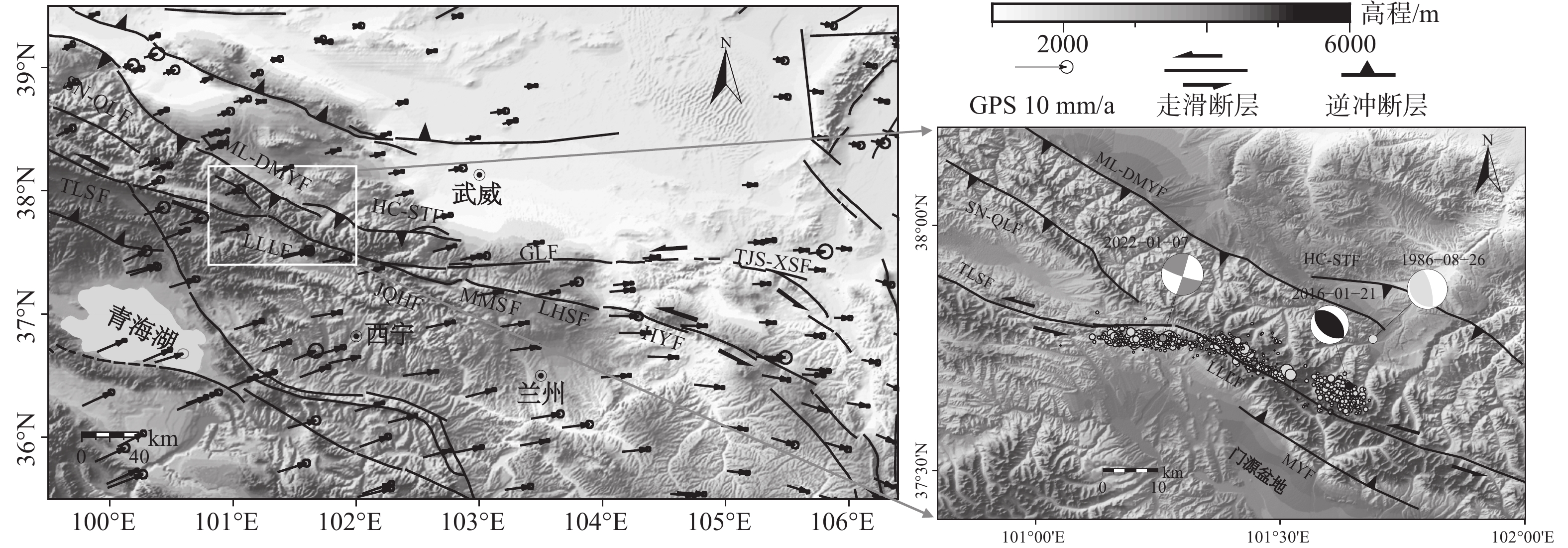
 下载:
下载:
